APPLICATIONS FOR DAYLIGHT SYSTEMS
 Studies have proven daylighting makes people more comfortable and productive. Reduced absenteeism, employee satisfaction and higher productivity are all bottom line benefits from the use of natural daylighting. An increase of just 1% in productivity could potentially provide enough financial savings to a company to pay their entire energy bill.
Studies have proven daylighting makes people more comfortable and productive. Reduced absenteeism, employee satisfaction and higher productivity are all bottom line benefits from the use of natural daylighting. An increase of just 1% in productivity could potentially provide enough financial savings to a company to pay their entire energy bill.
Of course, simply adding windows to a building is not enough, or not even an option in certain buildings. Daylight can also bring its own potential problems by introducing heat and glare into the equation. A good architect knows how to control, diffuse and use light to create a healthy and comfortable indoor environment.
Our quality of life, to a greater and lesser extent, relates directly to the amount of natural daylight we can access and enjoy.
When it comes to education, students who have access to natural light when they study are generally shown to have improved levels of concentration, and subsequently achieve better grades. And in health care, daylight increases our overall sense of well-being, which can dramatically reduce recovery times and improve general health rates amongst long-stay patients or residents of care homes.
In addition to meeting the challenge of providing daylight into buildings, designers are having to meet the challenge of increasingly stricter regulations regarding thermal efficiency and energy use. Solarspot® Tubular Daylighting Systems are widely employed across the world to provide the most efficient eco-friendly daylight solutions in virtually every building type.
With unsurpassed patented daylight delivery technologies, Solarspot® systems are able to deliver more light into the heart of a building, over longer distances and with greater efficiency than any other tubular daylight system. This superior efficiency allows designers to introduce daylight into areas that previously could only be lit artificially. It also allows for the introduction of daylight in a way that doesn’t compromise the thermal efficiency of a building.
To help give some idea of the vast range of Solarspot® installations, listed below are just a small selection of examples to illustrate the potential of this system.
HEALTH
The evidence for the beneficial effects of daylight on the human body is well established and for most people, something that is taken for granted. However, if you are a resident of a care home or confined to a hospital bed, your options are greatly reduced. The detrimental effects of daylight deprivation are well known and yet often over looked by building designers. And the staff and residents of these establishments are usually the ones to suffer.
The addition of systems like Solarspot® to provide daylight into day-rooms, dining areas, bedrooms and corridors of care homes, day centres and hospitals can dramatically increase the health and well-being of both residents and staff, which in turn translate into additional money saving for the organisations running such facilities.
EDUCATION
Major benefits to schools and colleges
- Reduced energy consumption and running costs
- Reduced carbon emissions
- Improved attendance
- Improved academic performance and results
If a school requires the electric lights to be on when it’s a bright day outside then the design could be accused of failing. Clearly, on ground-floor class-rooms with a second story above, over-head daylight may not be an option. But for the vast majority of class-rooms, a daylight solution, such as Solarspot® daylight systems, could be providing the light required for the majority of the year.
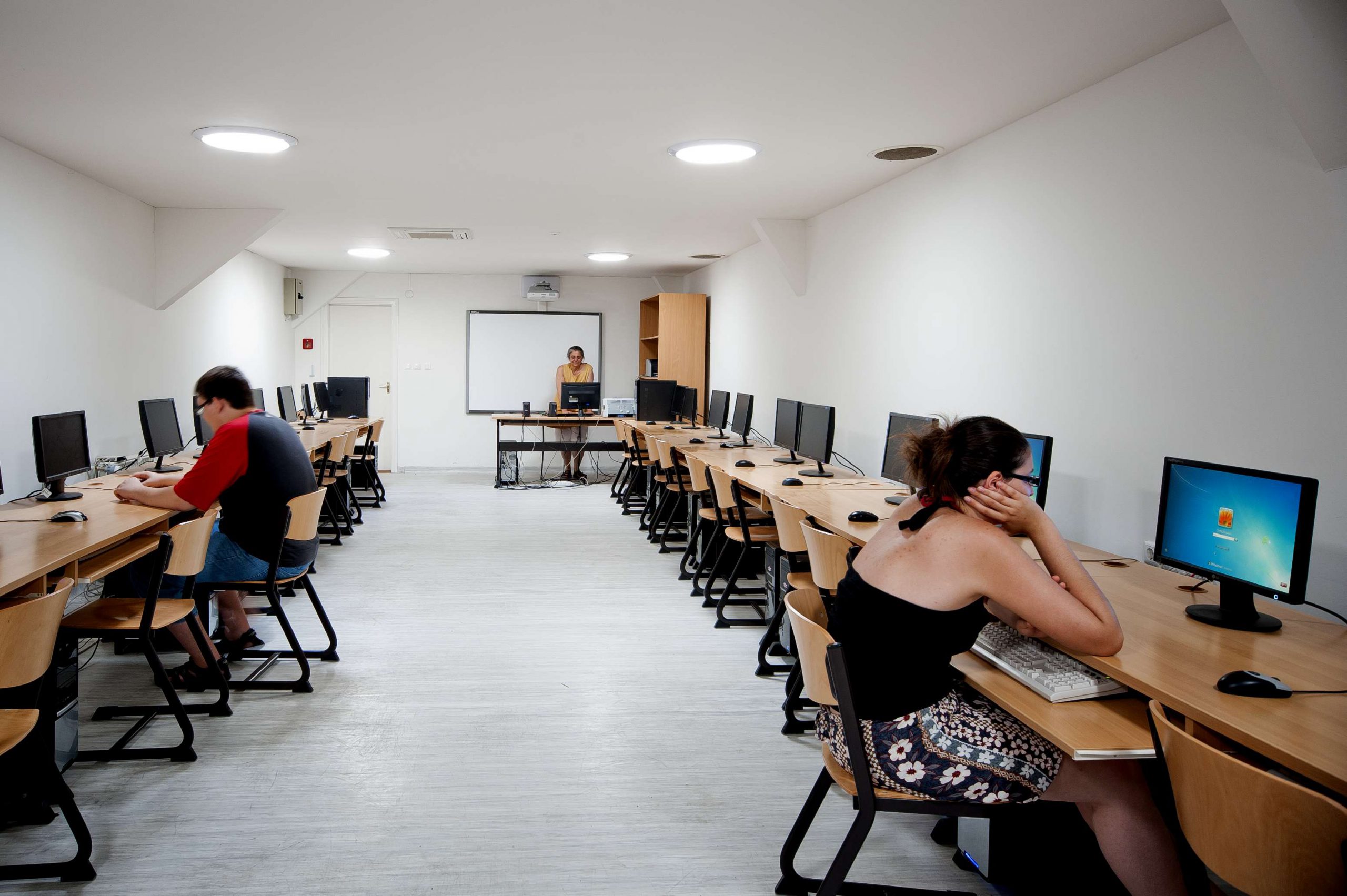 The inclusion of Solarspot® daylight systems into new build specifications or as a retrofit as part of a school refurbishment can deliver immediate results to reduce energy consumption and, therefore, a schools carbon footprint. Solarspot® daylight systems are perfect for all areas of a school building; class-rooms, offices and corridors, providing a free source of natural light saving the requirement for electric light for the majority of the life of the school.
The inclusion of Solarspot® daylight systems into new build specifications or as a retrofit as part of a school refurbishment can deliver immediate results to reduce energy consumption and, therefore, a schools carbon footprint. Solarspot® daylight systems are perfect for all areas of a school building; class-rooms, offices and corridors, providing a free source of natural light saving the requirement for electric light for the majority of the life of the school.
Correctly specified it would be reasonable to expect the requirement for electric light could be reduced by up to around 70% or more in areas where daylight systems are fitted. In schools that are completely single story, most primary schools for example, this could represent a total saving on electricity for the entire school of around 40% *.
Solarspot® daylight systems versus traditional roof windows
The traditional solution for over-head daylighting is usual met with the use of large, square roof lights, however there are several pit-falls that make them less than ideal for schools. Firstly there is no mechanism for distribution of light into the class-room resulting in a light ‘hot-spot’ directly below the roof light and dark areas away from it. Secondly, they can often be a source of glare. All Solarspot® daylight systems delivery light via a diffuser, evening out the light-levels throughout the room and eliminating any glare.
Roof lights can often be a thermal weak-point in the roof, allowing heat into class rooms during the summer whilst letting heat out in the winter. The excellent thermal properties of Solarspot® daylight systems ensure that any heat gain or loss is reduced to a minimum, meeting all part L requirements for thermal efficiency.
Finally, if installed as part of a refurbishment, Solarspot® daylight systems can be supplied is sizes that will fit through existing roof structures, eliminating the requirement for changes to the building fabric and greatly reducing installation times and costs.
* Based on schools using gas for central heating.
RESIDENTAL
The addition of a single Solarsot® D-25, 250mm diameter, system into a top floor internal bath or shower room, or a Solarspot® D-38, 380mm diameter, system at the top of a two story flight of stairs in a terraced townhouse can dramatically increase the sense of light and space for the future occupants.
Extending a home will often result in windows being lost or the room size being increased to the point where natural light can no longer reach into the back room. The utilisation of Solarspot® tubular daylight technology can allow increased flexibility for designers, developers and architects, allowing more options for the new building layout without compromising the natural light levels.
RETAIL
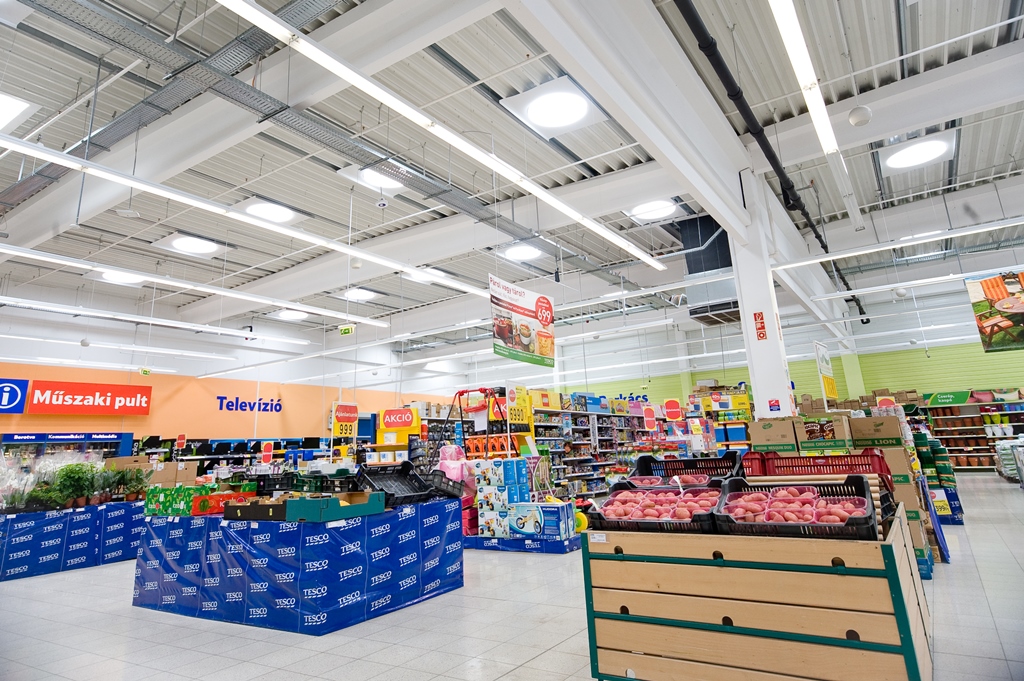 In Hungary the biggest continuous installation was in the sales area of the Tesco store in Oroszlány. Here we installed 120 pieces of 900 mm diameter Solarspot® tubular daylight system in the spring of 2013. The systems were installed in an existing, equipped sales area with 3000 m2 floorspace. This is the largest sales area in Hungary which is illuminated with daylight guidance systems.
In Hungary the biggest continuous installation was in the sales area of the Tesco store in Oroszlány. Here we installed 120 pieces of 900 mm diameter Solarspot® tubular daylight system in the spring of 2013. The systems were installed in an existing, equipped sales area with 3000 m2 floorspace. This is the largest sales area in Hungary which is illuminated with daylight guidance systems.
The natural light provides better well-being for the customers and for the staff as well.
There by improved the work performance of the staff working there and the customers are more prone to spend more time in stores and there fore likely to spend more money.
On bright days in the sales area of the store reflected the external levels, enhancing the customers well-being and reducing the contrast when entering or leaving the store against of the artifical illumination.
The artifical lighting is redeemable from sunrise to sunset by the systems what result is that natural lighting solutions have the potential to provide significant savings to retail chainswhilst boosting sales.
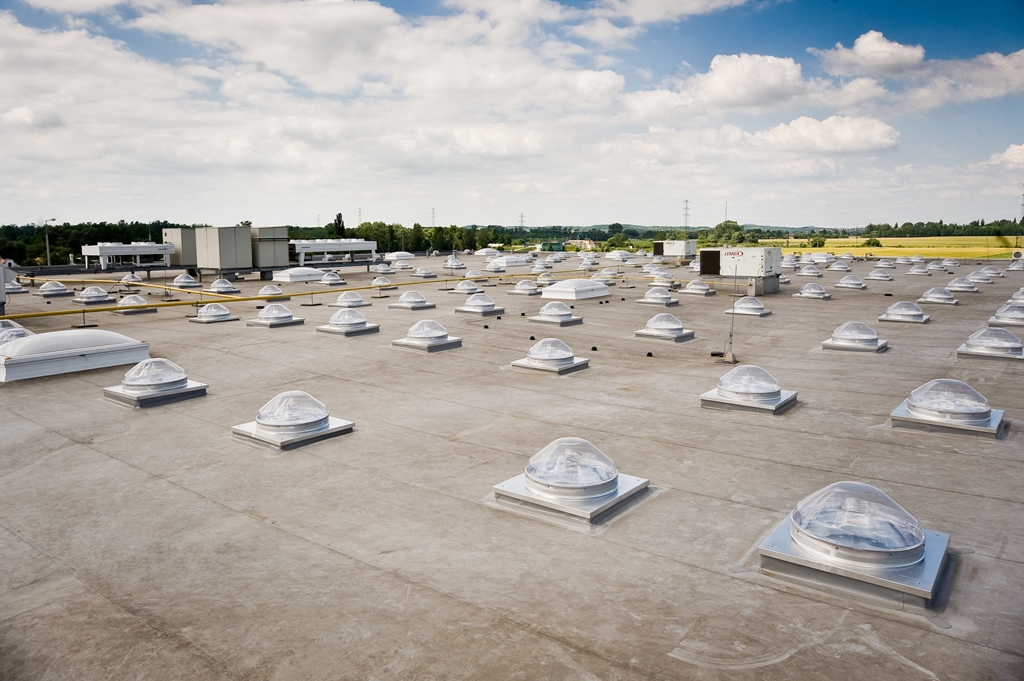
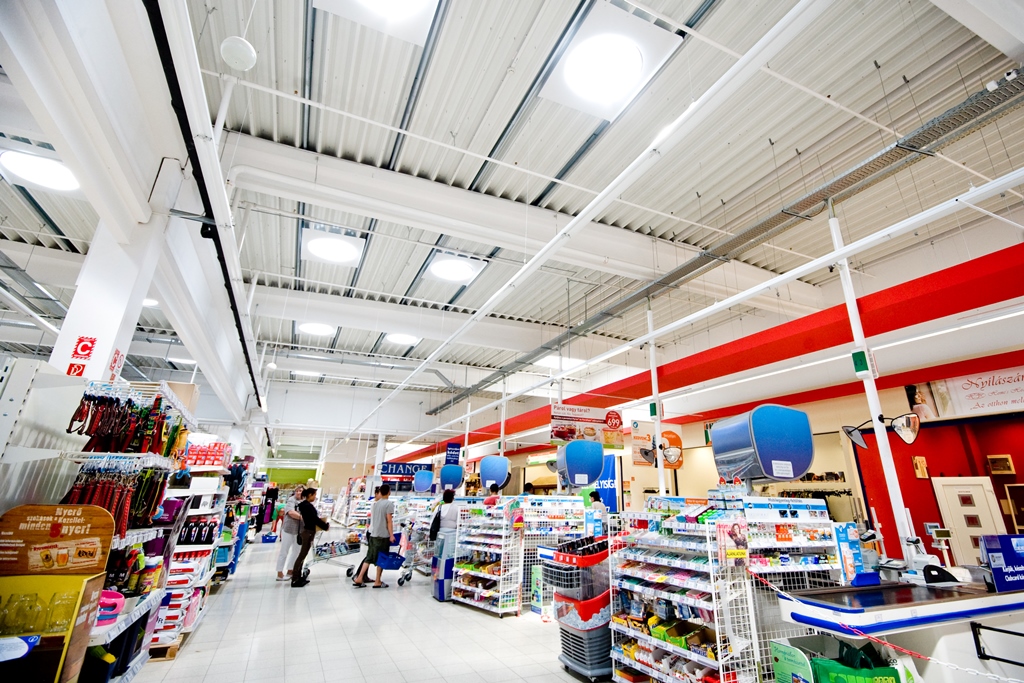
COMMERCIAL
 One of the major challenges faced by the modern workplace in recent years has been the quest to find ways to significantly reduce energy consumption. Faced with the prospect of rising energy costs, the drive to reduce carbon emissions and forthcoming behaviour-orientated legislation, many businesses are now becoming critically aware of their need to act. And the key areas where businesses can make serious reductions in energy use are lighting, heating and ventilation.
One of the major challenges faced by the modern workplace in recent years has been the quest to find ways to significantly reduce energy consumption. Faced with the prospect of rising energy costs, the drive to reduce carbon emissions and forthcoming behaviour-orientated legislation, many businesses are now becoming critically aware of their need to act. And the key areas where businesses can make serious reductions in energy use are lighting, heating and ventilation.
Solarspot® tubular daylighting systems are used in virtually all types of commercial and industrial building throughout the world. The addition of natural daylight to a building not only meets current demands to significantly reduce energy used for lighting, it also helps to prevent heat build-up from solar-gain and so helps reduce the cooling requirements – saving on air-conditioning as well.
In addition to the obvious benefits of reduced energy consumption, lower fuel costs and carbon emissions, there are direct benefits to the occupants of day lit buildings that include reduced absenteeism, improved feeling of well-being (combating ‘sick-building syndrome’ and SAD) and improved performance and productivity.
INDUSTRIAL
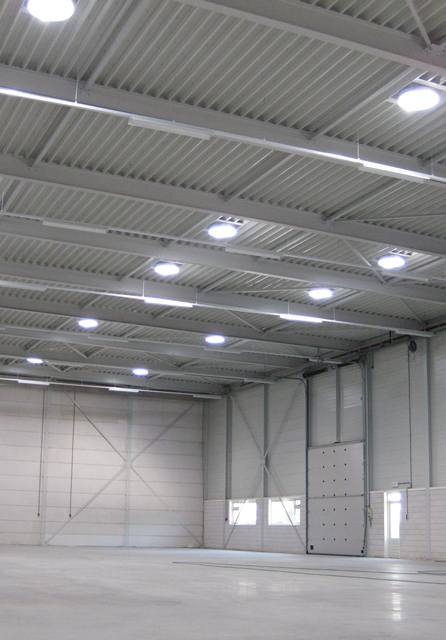 Intelligent building and refurbishment programmes incorporating modern tubular daylighting systems such as Solarspot®, could dramatically reduce the daytime power usage of Hungary business and industry. Industrial premises are ideal candidates for natural lighting solutions. For example, in a single story, metal-clad construction with no windows and rows of sodium or metal-halide lighting, the energy used for lighting would typically account for around 70-80% of the total power requirement for the building. If these lights can be turned off during daylight hours, the reduction in emissions and corresponding costs savings would be considerable.
Intelligent building and refurbishment programmes incorporating modern tubular daylighting systems such as Solarspot®, could dramatically reduce the daytime power usage of Hungary business and industry. Industrial premises are ideal candidates for natural lighting solutions. For example, in a single story, metal-clad construction with no windows and rows of sodium or metal-halide lighting, the energy used for lighting would typically account for around 70-80% of the total power requirement for the building. If these lights can be turned off during daylight hours, the reduction in emissions and corresponding costs savings would be considerable.
As well as a site-wide electricity reduction many companies who have incorporated daylighting systems also reported that the employees responded positively to working under natural light. In fact, many studies have proven that there is a link between daylight and improved productivity and reduced absenteeism.



